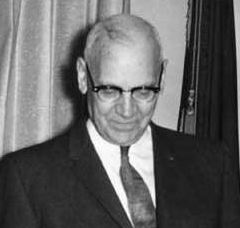Clarence Louis Anderson
From the finding aid for Clarence Louis Anderson papers 1894-1966 circa 1920-1960 (University of Washington Libraries Special Collections)

Clarence Louis Anderson was born September 30, 1894, in Seattle, Washington. In 1897 his father, Louis C. Anderson, traveled up the Yukon River to Dawson (Yukon Territory, Canada), where he helped organize the trading firm of Anderson Brothers and Nerland. Anderson's early life and schooling was spent in Dawson and then Seattle, where he finished grade school and high school. He went on to major in zoology at the University of Washington, where he specialized in fisheries biology under the guidance of Professor Trevor Kincaid -- then head of the Zoology Department -- and received a B.S. in zoology in 1917.
Upon graduation, Anderson was employed for two years by the U.S. Bureau of Fisheries to do fishery investigation and promotional work, mainly in Alaska and the Pacific Northwest. Much of that work involved demonstration of the "Scotch cure" -- a new method of fish cure specifically developed to better preserve herring -- to members of the local fisheries industry.
In 1919 Anderson returned to Seattle to teach various subjects at the newly-created University of Washington College of Fisheries, which was formally established April 2, 1919. In 1921, on a fellowship from the American-Scandinavian Foundation, he spent a year living in Norway and studying its commercial fisheries. Anderson returned to the University of Washington, where he continued to instruct while pursuing his master's degree. His thesis was based on experiments involving methods of pickling herring; in 1924 he received his master's degree in fishery science.
In 1927 Anderson became president and manager of Perfection Smokery ("Smoked and Salt Fish of All Kinds") in Seattle. He remained for fifteen years, before selling his business in order to take a position as chief technologist for the Washington State Department of Fisheries in 1943. His daily journal and field notes during this period reflect a focus on the population distributions of underutilized species such as the soft shell clam, an interest in fostering awareness of these resources throughout the regional industry, and the development of processes to make them commercially viable. During this time, he regularly returned to the University of Washington campus to lecture on marine fisheries products and preservation methods. In his six years with the Washington Department of Fisheries, Anderson rose to the level of assistant director and, briefly, director of fisheries.
In 1949 Anderson was appointed the first director of fisheries for the territory of Alaska. He spent the next twelve years building the department from a "tiny one-room office with a single employee" to a large, Juneau-based central office with branch and field offices, and over 170 permanent employees throughout the state (to whom he was invariably known as "Andy"). During this time, management of Alaska's game resources came under the jurisdiction of the department, and the Alaskan Territory was granted statehood in 1959. In the same year, Anderson was appointed commissioner of the Alaska Department of Fish and Game. In 1961 Anderson and his wife "Bertie" retired to a home on Mercer Island outside Seattle.
Clarence Louis Anderson died on April of 1966 on Mercer Island, Washington.
UA Site named after Clarence Louis Anderson
